

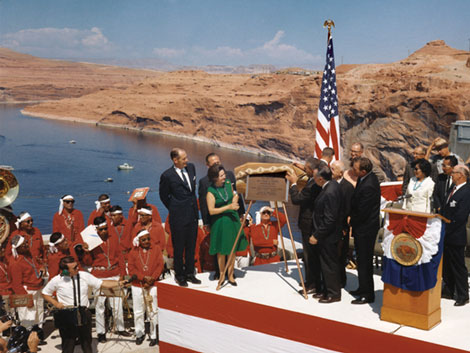 First Lady, Mrs. Lyndon B. Johnson, dedicates Glen Canyon Dam – 1966. Reclamation photo.
First Lady, Mrs. Lyndon B. Johnson, dedicates Glen Canyon Dam – 1966. Reclamation photo.(Adapted and excerpted from 2006 Bureau of Reclamation report on the Glen Canyon Unit of the Colorado River Storage Project by Jedediah Rogers)
The rich and controversial social and political history of Glen Canyon Dam began with the Colorado River Storage Project Act of 1956. CRSP authorized construction of the Glen Canyon Dam as one of four major storage reservoirs along the Colorado River and its tributaries. Few, if any, large-scale reclamation projects have generated as much controversy and emotion as Glen Canyon Dam and its reservoir, Lake Powell.
The site of the dam, 15 miles north of Lee's Ferry, Arizona, is a narrow gorge cut by the Colorado River. The canyon walls and foundation aremade of sandstone and shale.
Prior to the filling the reservoir, on canyon walls and river bottoms there were poignant reminders of a rich history, left behind by ancient Indians, Spanish explorers, Mormon pioneers, and enterprising businessmen. Reclamation officials did what they could to help record the history before it was lost. But salvaging the history of the canyon before the dam went up was secondary to the primary concern at hand: building a dam, a storage reservoir, and a hydroelectric plant.
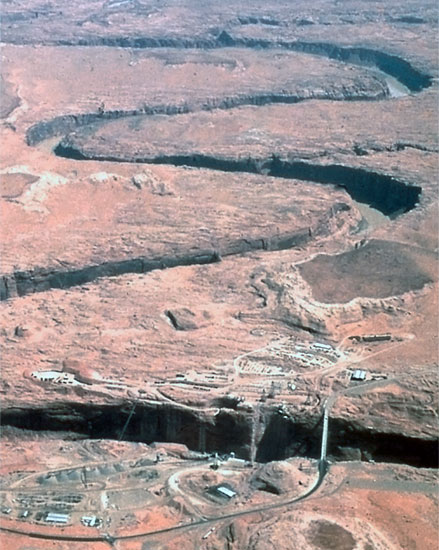 View of the Colorado River and the Glen Canyon Dam site – 1961. Reclamation photo.
View of the Colorado River and the Glen Canyon Dam site – 1961. Reclamation photo.Congress authorized Glen Canyon dam on April 11, 1956, with passage of the Colorado River Storage Act. The Glen Canyon Project was never meant to be a large-scale irrigation project. It would store upwards of 34 million acre feet of water, but little of that would water the thirsty crops of agriculturalists living in the high desert. Even the water that did would be heavily subsidized: as C. B. Jacobsen, chief of hydrology of Reclamation, told the Congressional committee, "The [upper basin] farmers can't pay a dime, not one dime." Instead, the dam's major purposes were to store water for future use by the lower basin states and provide hydroelectric power to a booming West. The dam would not only ensure that the upper basin states got their fair share of water, but it would pay for itself—that is, the sale of hydroelectric power would, in time, cover the costs of construction.
In total, the project would require, according to one estimation, "five million barrels of cement, ten million cubic yards of aggregate, three million board-feet of lumber, 130,000 tons of steel, 20,000 tons of aluminum, 5,000 tons of copper, and a peak workforce of 2,500 men."
The design was much like Hoover Dam—a combination gravity and arch dam, "built out of blocks."
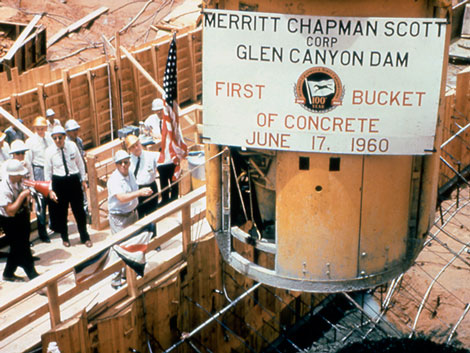 First bucket of concrete was poured at Glen Canyon Damon June 17, 1960, the 58th anniversary of the signing of the Reclamation Act of 1902. Reclamation photo.
First bucket of concrete was poured at Glen Canyon Damon June 17, 1960, the 58th anniversary of the signing of the Reclamation Act of 1902. Reclamation photo.For the honor of constructing the dam itself, bids opened on April 11, 1957. Merritt-Chapman & Scott Corporation won it at the incredibly low bid of $107,955,552.
On June 16, 1960, at a formal gathering attended by a few dignitaries, Secretary of the Interior Fred A. Seaton released the first 12 cubic yards of concrete at the toe of the dam. The dam was topped out on September 13, 1963, bringing the height of the dam to a towering 710 feet, just a few feet shy of Hoover Dam.
After 1963, the Glen Canyon Unit stood poised to fulfill its original purposes as a storage unit and a power generator. Large electrical towers were constructed on the canyon rim just above the dam. Ets-Hokin & Galvan received a $13 million contract to run a 345-kv power line 240 miles south to a substation at Pinnacle Peak in Arizona. From there, seven different lines ran to various corners of Arizona.
Dedication of Reclamation's newest dam did not take place until September 22, 1966, more than three years after waters had begun to rise. First lady Lady Bird Johnson spoke and dedicated the site. Two years later, on September 26, 1968, Interior Secretary Stewart Udall dedicated the Carl Hayden Visitor Center.
Project Benefits and Uses of Project Water
Construction boosted settlement in the area through the development of the town of Page, Arizona. Reclamation personnel had initially set out to create living space for the labor force that began to build the dam. The site chosen was 2 miles southeast of the dam site and named in honor of John C. Page, former Reclamation Commissioner.
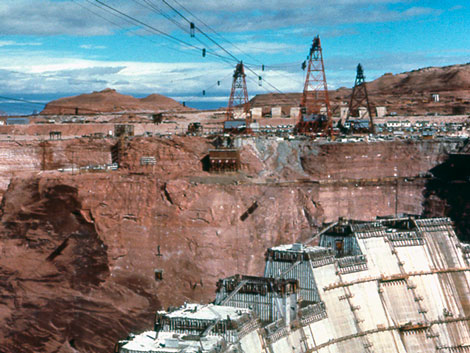 View of construction cableways at Glen Canyon Dam, 1963. Reclamation photo.
View of construction cableways at Glen Canyon Dam, 1963. Reclamation photo.At the beginning of 1959, the government had outfitted the new city of Page with electricity, temporary homes, and a school that served 200 students. By mid-1961, the population stood at 6,000, the tenth largest in Arizona, with a school enrollment of 1,500.
No water is pumped out of lake Powell except to the town of Page and to the Navajo coal-firing generating station, which is about one-quarter owned by Reclamation. Reclamation distributes some water for agriculture, but the dam's primary purpose is to store water so the upper basin states can deliver water to the lower basin states and to supply power to cities and towns in the Southwest. And, of course, there are the recreational benefits created by the dam and its reservoir, Lake Powell.
The 180-mile-long reservoir was named after John Wesley Powell. Its waters rose slowly, taking seventeen years before it filled for the first time. At full capacity, the waters reach only a few miles south of Canyonlands National Park near Cataract Canyon. Relatively unknown and inaccessible only a few years before, the Lake Powell National Recreation Area has since become familiar to millions.
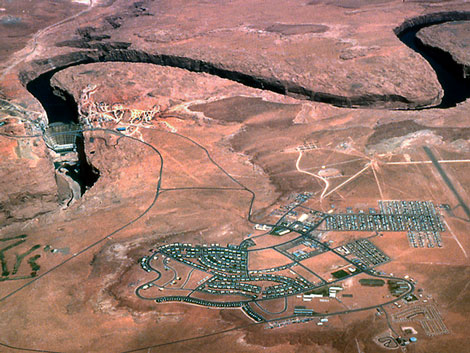 Aerial view of Page, Arizona – 1963. Reclamation photo.
Aerial view of Page, Arizona – 1963. Reclamation photo.In a speech delivered in April 1965, Reclamation Commissioner Floyd Dominy praised the reservoir for its many functions—drinking water electric power, tax revenue—but reserved his most potent praise for its use as a recreational haven "for thousands who might never experience these thrills of the outdoors if engineers had not inserted between the steep walls of Glen Canyon a mammoth concrete slab to control and clear the erratic river."
The Department of the Interior spent millions on internal improvements, such as marinas on the lake. Ten thousand people visited the lake in 1963, and 500,000 in 1965.
However people remember it or attach significance to it, Glen Canyon Dam and its reservoir continue to perform their original functions—to "control" the Colorado, to store water in a thirsty land, to generate hydroelectric power.
The full report can be read at:
http://www.usbr.gov/projects//ImageServer?imgName=Doc_1232657383034.pdf
